Summer isn’t quite complete without the cheerful buzz of hummingbirds in your backyard. With so many hummingbird flowers to choose from, it can be overwhelming to pick the right ones. Do hummingbirds like petunias, or do they prefer snapdragons? This is where our friends at All-America Selections can help. We looked at some of their best nectar-rich picks from past years to put together this list. Give these award-winning annual flowers a try in your garden. Your hummingbirds will thank you!
These top 10 plants, like all other AAS winners, are top of their class. How does it work, exactly? AAS is an organization made up of seed-industry professionals, and they conduct confidential and impartial trials of never-before-sold seed varieties throughout North America. They grow established varieties next to the new entries for a comparison of growth habit, flower or fruit size and many other factors. Only the best performers are declared AAS Winners.
Do Hummingbirds Like Cleome?
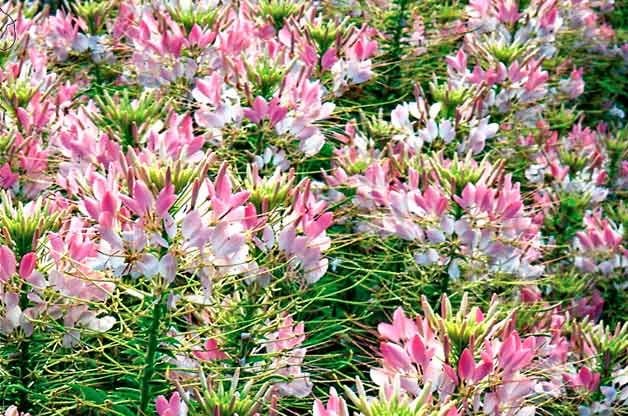
Grow Sparkler Blush cleome (Cleome hasslerana, 2002 winner). Not your typical cleome, this hybrid was a breeding breakthrough when it was introduced. Densely covered with pink flowers, it’s more closely branched than other cleomes. This gives it a denser appearance on a more compact plant.
Why we love it: The airy blush-pink florets attract hummingbirds, and butterflies and bees, too. It makes an excellent annual garden hedge.
Do Hummingbirds Like Verbena?
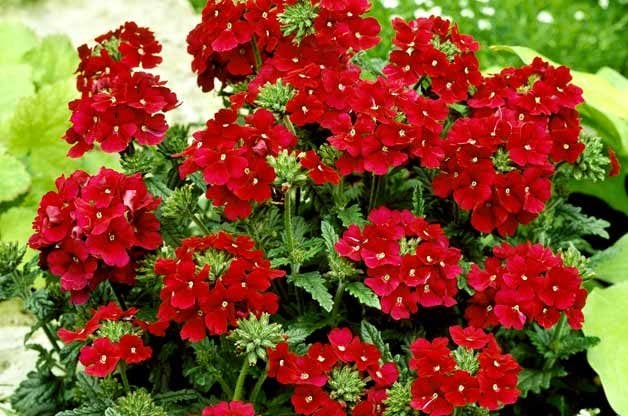
Look for Quartz Burgundy verbena (Verbena x hybrida, 1999 winner). The intense wine-colored florets will attract hummingbirds first with their red flower color, then with their nectar. Improved resistance to mildew means this annual will flower a lot longer than many other verbenas.
Why we love it: With a full season to blossom, this verbena will thrive in any container or hanging basket.
Do Hummingbirds Like Begonias?
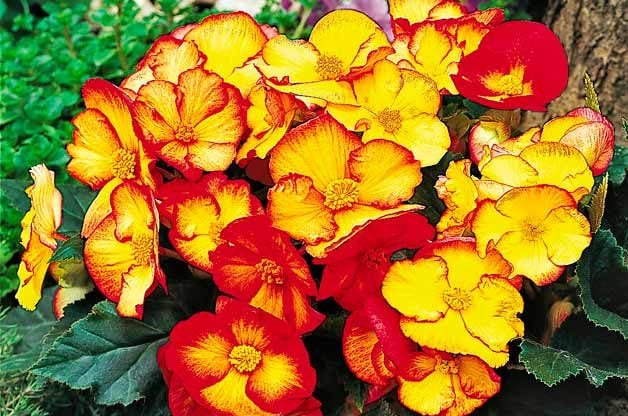
Try Pin Up Flame begonia (Begonia x tuberhybrida, 1999 winner). This stunning tuberous begonia variety produces loads of 4- to 5-inch single blossoms in a glowing combination of deep yellow with scarlet and orange edges. A prolific bloomer with good weather tolerance and durability, Pin Up Flame will give you fabulous color from summer through fall.
Why we love it: All by itself, this begonia will brighten up a shady garden. With minimal care, it’s perfect for a patio container, even in your least sunny spots. Discover the top 10 hummingbird plants that grow in shade.
Psst! Find out if firebush attracts hummingbirds, too.
Do Hummingbirds Like Dianthus?

Try Jolt Pink dianthus (Dianthus interspecific, 2015 winner). Exceptional, long-blooming garden performance, heat tolerance and attractive flower form and color make this winner worth considering for your garden. Hummingbirds are attracted to the color and to the plentiful supply of blossoms this annual produces throughout the season.
Why we love it: In addition to its grace in the garden, Jolt Pink makes a lovely cut flower.
Do Snapdragons Attract Hummingbirds?
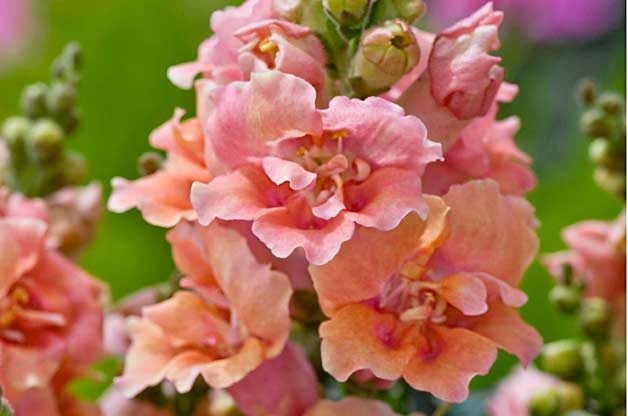
Look for Twinny Peach snapdragon (Antirrhinum majus, 2010 winner). The shape of this variety’s colorful florets makes it especially easy for hungry hummingbirds to reach the nectar. With their bewitching blend of peach, yellow and light-orange blooms, these snapdragons provide excellent coverage for both annual borders and containers.
Why we love it: These easy-care plants show exceptional tolerance to hot summer growing conditions.
Do Hummingbirds Like Nicotiana?
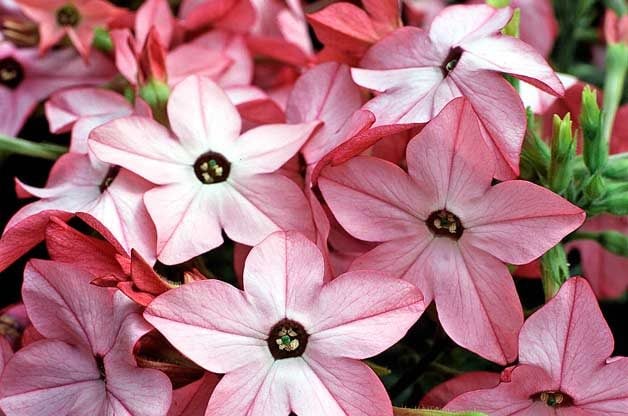
Try Avalon Bright Pink nicotiana (Nicotiana x sandarae, 2001 winner). This dwarf variety of flowering tobacco is one of the smallest and earliest-blooming available. Plants are super-branched, providing a framework for masses of bright-pink flowers that blossom freely all summer long—a real treat for hummingbirds!
Why we love it: The star-shaped blooms are visible from quite a distance. The plant is also virtually maintenance-free, making it perfect for both border and container planting.
Do Hummingbirds Like Salvia?
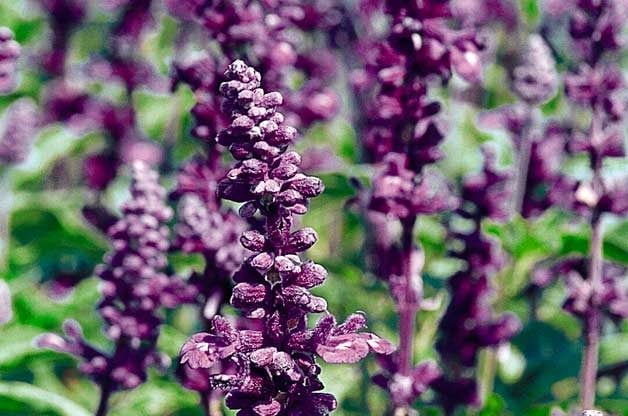
Try Evolution salvia (Salvia farinacea, 2006 winner). This variety expands the salvia color range with its lilac spikes. Hummingbirds, bees and butterflies are attracted to the well-branched, robust plants.
Why we love it: Pair it with a Lady in Red or Summer Jewel variety, and you have a hummingbird magnet!
We love these hummingbird decor items for homes and gardens.
Do Hummingbirds Like Petunias?
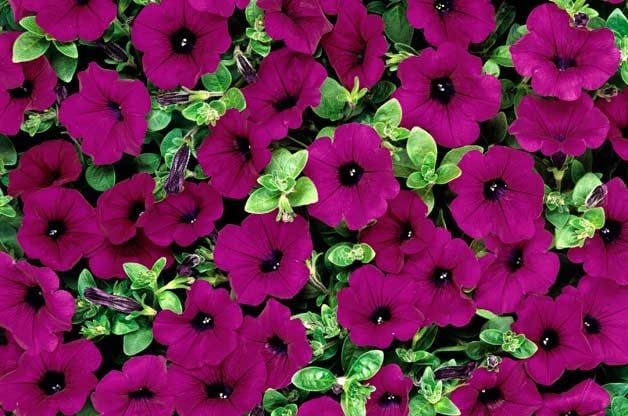
Grow Purple Wave petunia (Petunia x hybrida, 1995 winner). This highly popular variety has flower power to spare. The abundance of iridescent purple blossoms draws both hummingbirds and bees. Even better, it was recently improved for earlier bloom time and slightly larger flowers without sacrificing the eye-catching color.
Why we love it: This petunia has a vigorous spreading growth pattern. Use it as a ground cover or to design an astounding hanging basket. Learn why wave petunia plants blow other petunias out of the water.
Are male hummingbirds territorial at feeders and flowers?
Do Hummingbirds Like Marigolds?
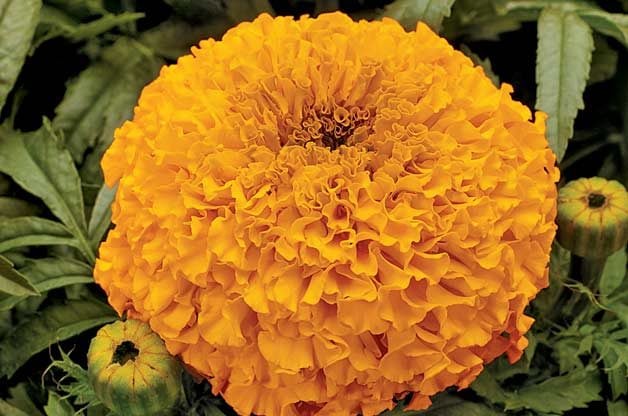
Grow Moonsong Deep Orange marigold (Tagetes erecta, 2010 winner). The flower color is fade-resistant and such a rich orange it makes others look pale by comparison. Easy to grow in 5- to 6-inch pots, plants will flower in about 70 to 84 days.
Why we love it: Over the summer, the old blooms will be covered with green foliage, which keeps the plants looking fresh throughout the growing season.
Learn how to identify a ruby throated hummingbird.
Do Hummingbirds Like Zinnias?
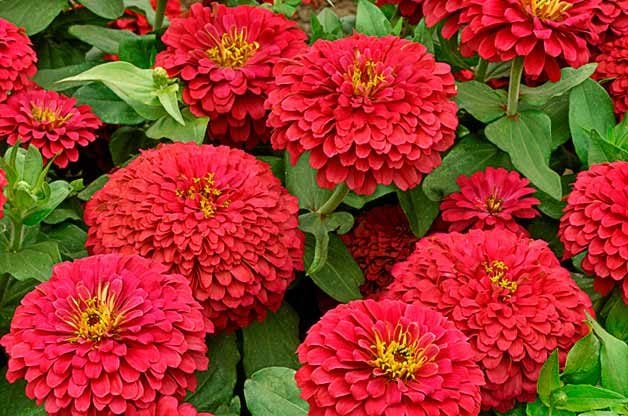
Try Magellan Coral zinnia (Zinnia elegans, 2005 winner). This garden zinnia produces masses of clear, bright-colored double coral blooms on bushy, well-branched plants. After the first bloom is over, it treats you to another flush of flowers, lasting all season long.
Why we love it: This is only one of six colors in the Magellan series, which performs beautifully outdoors in gardens and containers.
Next, discover why you should add a hummingbird mint plant to your yard.
Through the years, occasional sightings of bright yellow cardinals have fascinated the internet. The Northern cardinal is such a distinctive bird that even non-birders recognize its red-and-black coloration and perky crest at first sight, but a yellow cardinal? That bird catches the eye and the imagination. Psst—if you see a cardinal, here’s what it means. And, here’s what you need to know if you think you spotted a blue cardinal.
In recent years, birders have spotted a yellow cardinal in Alabama and Illinois. Now a birder (and Birds & Blooms field editor!) from Florida has spotted a yellow cardinal bird in Gainesville. Here’s what we know.
Why is the Yellow Cardinal Not a Red Bird?
Northern cardinals get their vivid red color from pigments in their food called carotenoids. Foods with yellow pigments transform into red in the birds’ bodies, hence the red feathers. Female cardinals are mostly brown with red accents. Scientists theorize this yellow cardinal bird has a genetic mutation that stops the color changing process, resulting in those sunshine-colored feathers instead. It’s also possible the bird could be sick or stressed by environmental factors, causing the same problem. Without DNA testing, it’s impossible to know for certain.
Check out proven ways to attract cardinals.
When Did the Yellow Cardinal Appear in Gainesville, Florida?

Tom Dotson, Birds & Blooms field editor who lives in Florida, says he learned of the bird’s appearance from Facebook groups and a USA Today article. “They all kind of talked about him and said he was in a specific area, and I thought, Well, that’s not that far,” Tom says. “For about a month, I decided I’d take the trip up.” He’s made several trips to see the bird since.
Tom first went to Gainesville to spot the yellow cardinal on March 13, 2022. The yellow cardinal is located on the outskirts of the University of Florida campus — it’s an unexpected location for such an incredibly rare and exciting bird. “It was kind of surprising that of all the places he could pick, that would be the one,” he laughs. “But it’s a nice area that he’s in. Very pretty. He has good taste!”
We found the best cardinal bird feeders and birdseed.
Finding the Yellow Cardinal

When Tom arrived, there were two other birders there; one from Ohio and another he thinks was from Indiana. They located the bird within five minutes, and, thankfully, the yellow cardinal stayed within the same area the whole time Tom was there. He says that when he made a return trip, the bird was in that same location.
Check out more simply stunning photos of cardinals.
Given the extreme rarity of the bird, finding the yellow cardinal was a special moment for Tom. “I have never seen another one,” he says. “I had heard that they existed, but they’re supposed to be pretty rare — I wanted to be able to put my eyes on one if possible. Supposedly there’s eight or nine of them in the world at a given time, it’s just a matter of finding them!” Have you ever seen a red crested cardinal?

Tom’s concern about the yellow cardinal is that the area in which it lives has had heavy rainfall lately. That might make food harder to find for the bird. But he also notes that there were about six other pairs of cardinals where the yellow bird was, so this species must like it there. “It’s a nice place for him,” he says.
You need to see these photos of white cardinals and other leucistic birds.
The field editor has traveled the state of Florida looking for birds, and he’s especially proud of a sighting of a pair of whooping cranes. The yellow cardinal, though, just might have surpassed them. “I have found a couple other pretty impressive lifers for me that I’m happy with, but with this one, knowing there’s only a few here and there, is special… this one probably takes No. 1,” he says.

Looking forward, Tom says he hopes to see the yellow cardinal again. “[It was] super, super interesting,” he says. “He’s a really cool bird. I hope he doesn’t get bombarded with so many people that he goes away, but it hasn’t happened so far, and he’s been on some pretty big platforms. I hope it dries out soon, because [the area] is under a lot of water… Hopefully he stays there, and I can go visit him.”
Discover interesting cardinal bird facts you should know.
Other Yellow Cardinal Bird Sightings
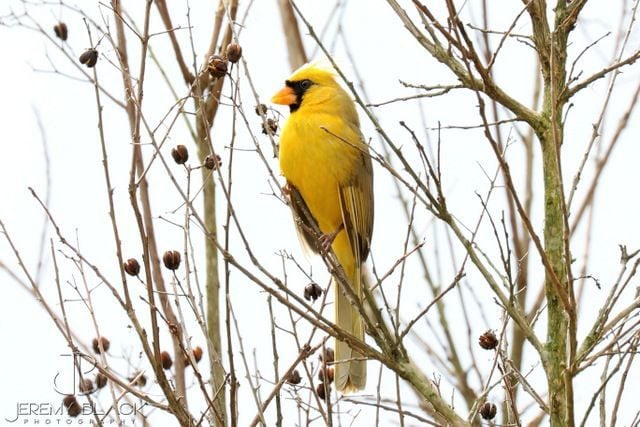
In February 2020, birder Chelsea Curry photographed a yellow cardinal in rural Rushville, Illinois. Auburn University biological sciences professor Geoffrey Hill confirmed the rare sighting. A few years before that, professional photographer Jeremy Black and Charlie Stevenson spotted a similar bird in Alabama.
“When the bird landed in her neighbor’s crape myrtle tree and I saw it for the first time, it took my breath away,” Jeremy said. “It was sitting 15 feet away from me. The way the sunlight cascaded upon it, for a moment I completely forgot that I was supposed to be taking pictures of the bird! I managed to only capture a few shots before a squirrel scared it away. Those moments are irreplaceable and I wouldn’t trade them for the world.”
Next, don’t miss the best cardinal gifts for redbird lovers.
When spring rolls around—especially in anticipation of Easter—tulips, daffodils and irises make colorful appearances in and around many homes. You can be sure to find these classic flowers in Easter bouquets near the grocery store checkout. But if you’re looking to add something different (and humorous) to your spring plant lineup, look for an Easter egg plant.
The name is slightly misleading—this plant doesn’t grow eggs for you to pluck come Easter morning. However, it might as well!
Learn more about early-blooming flowers for spring.
What is the Easter Egg Plant?
This Easter egg plant, or Solanum ovigerum, is actually a miniature type of eggplant. It’s not the deep purple color we’re familiar with, but there are still a handful of similarities to the fruit we use in eggplant Parmesan.
View this post on Instagram
For starters, not all types of eggplant are a royal purple hue. Some are bright white, striped or pastel purple. The fruits that grow from the “Easter egg” plant start off white, but ripen to shades of yellow, orange, cream and green, says Park Seed. And, you guessed it, their shape closely resembles that of an actual egg, versus the oblong purple fruit we’re used to picking up in the produce section.
Find out how to decorate adorable flower pot Easter eggs.
Can You Eat the Easter Eggplants?
You can, but you probably don’t want to. The ornamental fruit doesn’t taste much like the eggplant you’re used to cooking with. Stick to traditional globe eggplants when it comes to preparing eggplant recipes. Check out the top 10 herbs to grow for cooking.
Where to Find an Easter Egg Plant
Look on Etsy! You can find a small plant that’s ready for the garden or start with a packet of seeds.
Your best bet is to grow this plant outdoors to meet sunlight and temperature requirements, but you can start seedlings indoors. The growing plant will need about six hours of sunlight each day, meaning that you need to situate it comfortably by a window or under a grow light.
Then, come spring, you can transplant the growing Easter egg plant outdoors, or simply move your pot outside. Look for purple flowers in late spring, and for the egg-like fruits to start growing mid-summer.
On This Page
What Does a Ruby-Throated Hummingbird Look Like?

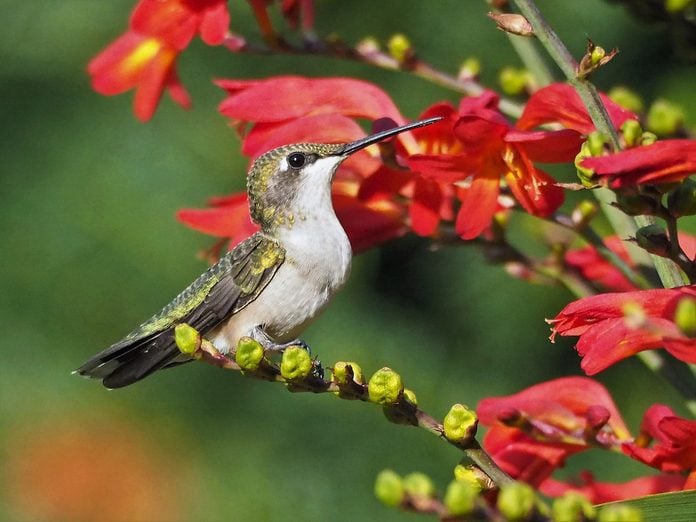
The male ruby-throated hummingbird steals the show with a green body and ruby red throat that glistens like jewels in the sunlight. Its vibrant green head glows, too! The female isn’t as grandiose in appearance. It sports a green head with white underparts and black masks near the eyes. Both sexes have a metallic green back. They measure about 3 3/4 inches long with a wingspan of 4 1/2 inches.
You need to see these stunning hummingbird pictures.
Ruby-Throated Hummingbird Nest
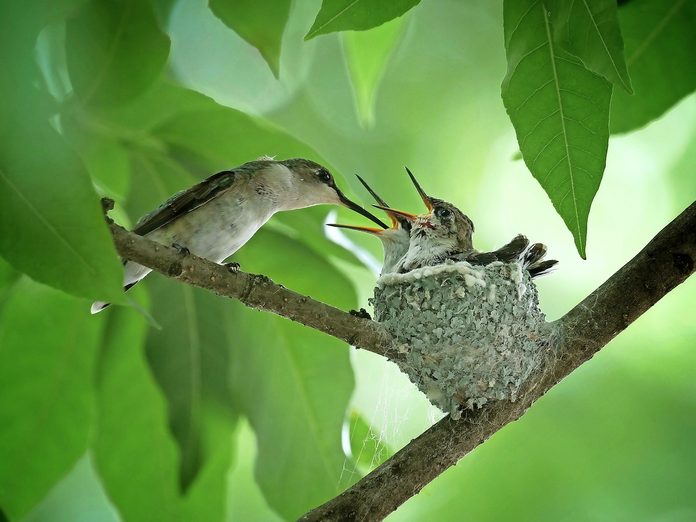
From midspring through late summer, the female ruby-throat is constantly on the move. She chooses a nest site, builds a nest, incubates eggs and raises the baby hummingbirds all on her own. The males don’t play a role. She’s doing all this while trying to keep herself fueled and fed!
These tiny fliers build a cup-shaped nest with moss, spiderwebs and camouflaged with lichen. The female lays two tiny white eggs that look like jelly beans.
Learn more about the life of a female hummingbird.
Juvenile Ruby-Throated Hummingbird
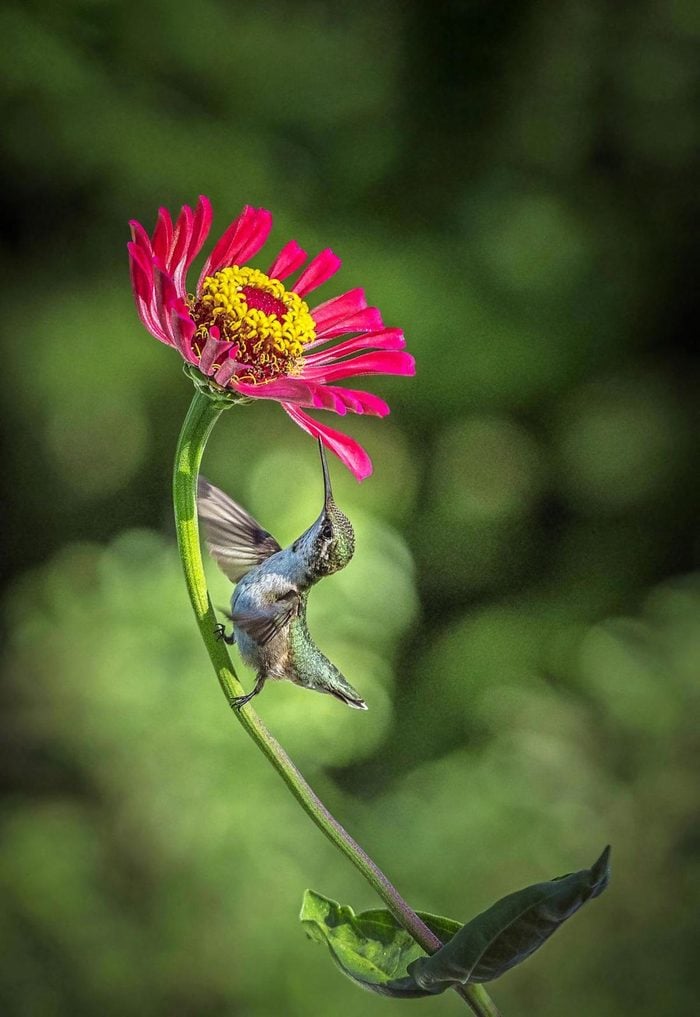
All juvenile ruby-throated hummingbirds look so similar to females that it’s often nearly impossible to tell the difference. About 15 days after hatching, baby hummingbirds stand up on the edge of the nest and exercise their wings. They leave the nest a few days later. Young fledglings can’t feed themselves; it takes practice to hover and drink nectar. The female continues to feed them for up to a week as they learn how to find food.
Whether a male, female or juvenile ruby-throated hummingbird chooses your yard, their acrobatic, territorial and erratic antics always entertain.
Check out jaw-dropping facts about hummingbirds.
What Do Ruby-Throated Hummingbirds Eat?

Ruby-throated hummingbirds zip, zoom and dart from one food source to another. Because they constantly burn energy while on the move, they may eat up to two or three times their body weight (which is less than a penny) in a day. Their diet consists of nectar, small insects and tree sap. Invite these teeny delights into your yard with offer sugar water and tube-shaped flowers in their three favorite colors: red, orange and pink.
Check out the best colorful hummingbird flowers to grow.
Ruby-Throated Hummingbird Call
Listen to the ruby-throated hummingbird to help identify them. This bird makes a soft “tew” and a rapid series of chipping notes.
Bird songs provided by the Cornell Lab of Ornithology.
Do hummingbirds sing? Hear the many sounds of hummingbirds.
Habitat and Range Map
Several hummingbird species are sprinkled over the western half of North America, including Anna’s and Allen’s hummingbirds. But only one, the ruby-throat, flies the eastern skies regularly. Look for them in gardens, woodland edges and parks.
Among the most common and successful hummingbirds, ruby throats are found in summer across most of the eastern U.S. and east of the Rockies in southern Canada. Their population totals an estimated 34 million birds.
Do hummingbird sightings have special meaning?
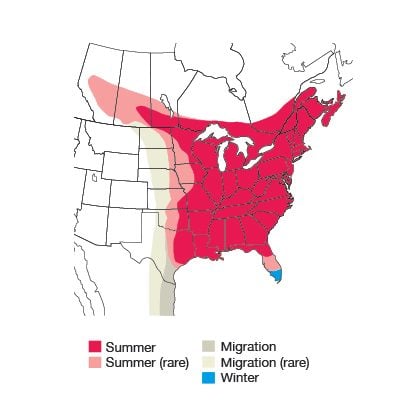
Range maps provided by Kaufman Field Guides, the official field guide of Birds & Blooms.
Ruby-Throated Hummingbird Migration

Ruby-throated hummingbirds move south in late summer and early fall. Ruby-throats may fly more than 3,000 miles from Canada to Costa Rica. And some fly nonstop 500 miles across the Gulf of Mexico during migration. That’s quite a feat for a bird that weighs a little less than 4 grams.
They need food sources to fuel their migration journey. A good rule of thumb is to leave your feeders up for a couple of weeks after you see the last one pass by.
Wing Speed and Heart Rate
These little creatures fly about 25 miles per hour and zoom even faster when the wind pushes them along. Zipping around in every direction (even backward), the nimble ruby-throated hummingbird beats its wings around 53 times per second.
When ruby-throats are really exerting themselves, their hearts race around 1,200 beats per minute. In calmer times, that rate drops to 600 beats per minute. Humans, in comparison, have a resting heart rate of about 72.
Next, find out where do hummingbirds sleep at night?
Why Trust Us
For nearly 30 years, Birds & Blooms, a Trusted Media Brand, has been inspiring readers to have a lifelong love of birding, gardening and nature. We are the #1 bird and garden magazine in North America and a trusted online resource for over 15 million outdoor enthusiasts annually. Our library of thousands of informative articles and how-tos has been written by trusted journalists and fact-checked by bird and garden experts for accuracy. In addition to our staff of experienced gardeners and bird-watchers, we hire individuals who have years of education and hands-on experience with birding, bird feeding, gardening, butterflies, bugs and more. Learn more about Birds & Blooms, our field editor program, and our submission guidelines.
It’s a magical moment when a hummingbird zips through your backyard or stops at your sugar-water feeder for a snack. From a ruby-throated hummingbird enjoying a refreshing rain shower to a male Anna’s hummingbird territorially puffing himself up, we’ve gathered together some of our favorite, jaw-dropping hummingbird pictures from Birds & Blooms readers. You can submit your own hummingbird pictures to us using our submission form. Enjoy!
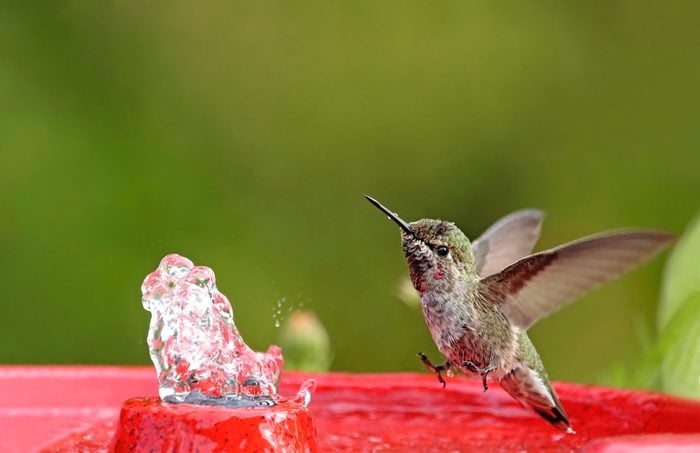
Amazing Hummingbird Pictures
I keep a bubbling jar fountain in the middle of my garden that attracts many different birds. Some of my favorite birds to watch splash around are hummingbirds. This young male Anna’s hummingbird visited a few days in a row in June, each time inspecting the fountain a little bit closer. Finally, he decided to be brave and truly dive into the water. I was happy to catch him in action!
Jaklyn Larsen of Florence, Oregon
Bonus! jaw-dropping facts about hummingbirds
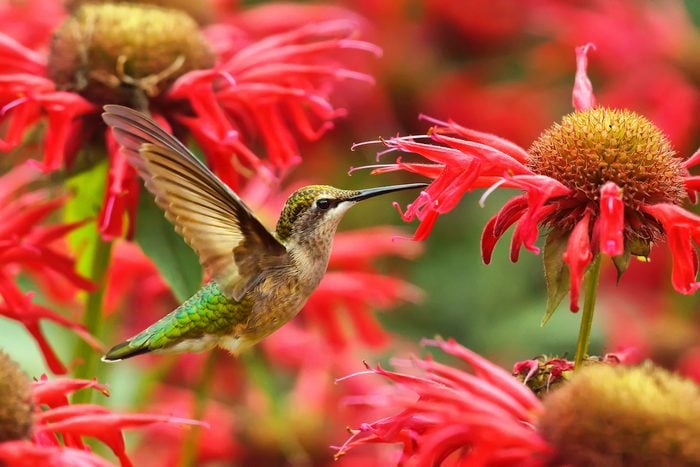
Hummingbird at Bee Balm
I captured this wonderful image of a female ruby-throated hummingbird while at the Stony Creek Metropark Nature Center in Shelby Township, Michigan. The experience inspired my family and me to grow a fairly large patch of scarlet bee balm in our hummingbird garden.
Sharon Sauriol of Washington, Michigan
Check out the top 10 red flowers that attract hummingbirds.

Stick Out Your Tongue
This juvenile male ruby-throated hummingbird kept coming back to this rose of Sharon bud to rest briefly. After a few attempts, I finally got a hummingbird photo with his tongue, which appeared for a split second. He seemed to be quite comfortable in my presence.
Vanessa Woodlock of Goldsboro, North Carolina
Learn how hummingbirds use their tongues and beaks.

Perfect Perch
This male Anna’s appeared in my backyard in Southern California. He has many perching spots in my yard, but he came out to guard the top of the hedges this day. I used a Canon EOS 6D Mark II camera to take this hummingbird photo.
Monica Slack of El Cajon, California
Do hummingbird sightings have special meaning?

Spring Migration
The calliope hummingbird is a rare summer migrant to the urban areas of San Diego. When a male was spotted close to where I live, I went repeatedly to the area of the sighting to perform a stakeout. I finally got a glimpse of this beautiful bird just long enough to snap a couple of hummingbird photos of it visiting white sage flowers. It’s the only calliope hummingbird I’ve ever seen.
Aicha Ennaciri of San Diego California
Was the Lucifer hummingbird really named after the devil?

Hummingbird and Hibiscus
Each August we stay with our friend in Bethany Beach, Delaware, to take hummingbird photos. We had hoped that the fast fliers would go for her hibiscus flowers, but the whole time we were there, no dice. I started to pack up my camera equipment to leave when this ruby-throated showed up!
Suzanne Cassidy of Hughesville, Maryland
Check out 14 proven hummingbird photography tips.

Strike a Pose
My husband hangs several hummingbird feeders every year from a long wire across our deck. For this photo I was using a new Canon telephoto lens on my camera, which was mounted on a tripod. Hoping to get a good shot of a male ruby-throated who had his wings out, just daring another hummer to come close, I snapped a series of photos to get this particular one.
Felice Bond of Williamsburg, Virginia
These photos show just how gorgeous hummingbird’s colors are.

Buzz Off
This female black-chinned hummingbird was attempting to drink sugar water from the feeder hanging in our front yard when a wasp decided it also wanted some. The photo shows the anxiety and frustration coming from both the hummingbird and the wasp as they attempted to use the sugar-water feeder at the same time.
Ginny Phillips of Prescott, Arizona
We found natural ways to keep bees and wasps away from hummingbird feeders.
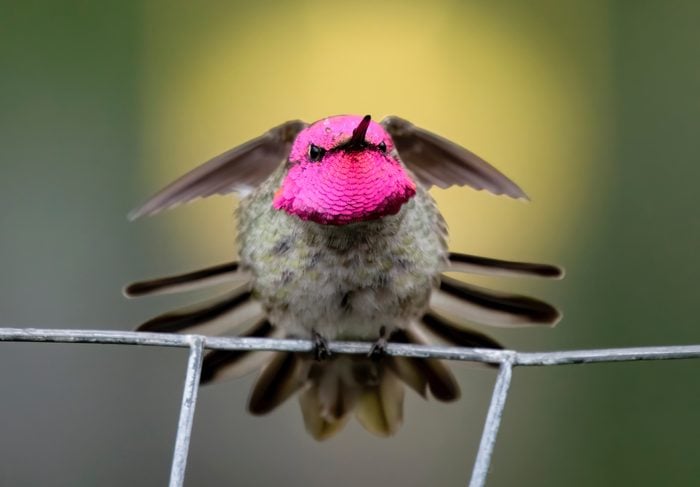
Anna’s Hummingbird in the Rain
This hummingbird photo was taken on a rainy day. Anna’s hummingbirds often stretch before flight if they’ve sat for 10 minutes or longer. This guy put on a terrific show, and I happened to be in the right place with a camera and a nice background.
Elijah Gildea of Redding, California
Learn how to attract more hummingbirds for less money.

Hummingbird in the Birdbath
This precious jewel of nature was ready to take a bath. I took this hummingbird photo in the early hours of the morning, not during the high heat of the day. Hummingbirds like to clean their bills from all that sticky nectar and pollen and also wash off their feathers to keep fresh and clean.
Gilberto Sanchez of Orlando, Florida
Psst—this is the only homemade hummingbird nectar recipe you need.

Hummingbird Garden
I was weeding my garden when a broad-tailed hummingbird came to visit the flowers next to me. I usually have my camera with me, so I quickly grabbed it and snapped as many photos as I could before this little guy zipped away. The flier mostly stayed on the side, where I couldn’t see it, but for a few seconds it came perfectly into view.
Sonja Puhek of Colorado Springs, Colorado
Here’s how to create an ideal hummingbird habitat.

Flag and Hummingbird
Shortly after hanging our American flag on our deck, this male ruby-throated hummingbird flew in front of it to the feeder. It captured my patriotic heart, so I ran for my camera to take a hummingbird photo of two of my favorite things together: our flag waving in the breeze and a lovely hummingbird in flight.
Barbara Reams of Pinckney, Michigan
Learn about the 15 types of hummingbirds found in the United States.

Hummingbird Nest
In late spring, I was lucky enough to find an Anna’s hummingbird nest with two newly hatched babies. Over the course of about three weeks, I visited the nest often and documented the progress of the family with my camera. In this moment, Mama was just returning to her nest of two well-fed babies, both with beaks wide open in anticipation of their next meal.
Paul Marto of West Jordan, Utah
Discover everything you need to know about hummingbird nests.

Red Flowers
Cardinal flowers rely heavily on ruby-throated hummingbirds for pollination. As a hummingbird’s forehead comes in contact with a bloom, it unknowingly collects the pollen, which the hummingbird then hopefully carries to another cardinal flower bloom.
Laurie Dirkx of Ontario, New York
These super cute hummingbird moments and stories are sure to bring a smile to your face.

Hummingbird Haven
“Every summer I try to get to a local preserve frequented by ruby-throated hummingbirds. It’s a good place to meet other photographers. I saw this lovely hummingbird on a bright sunny day,” says Robert Kaplan of Roslyn Heights, New York.
Learn how to attract hummingbirds with 10 expert tips.

Golden Glow
“This rufous hummingbird was aggressively guarding the feeder we had just put out. But he sure was a joy to watch, with his brilliant orange gorget shining in the sunlight,” says Deborah Whiting of Midland, Texas.
Learn how hummingbirds can fly backwards.

Spectacular Colors
“I’d been trying to get hummingbird pictures of a bird sitting on a branch with a nice background for a very long time. I was really excited when this male broad-billed hummingbird perched so close to me,” says Jane Miller of Tucson, Arizona.
Discover the best sites for viewing Arizona hummingbirds.

Gardening for Birds
“Some of my best photos are taken right in my backyard. I plant perennials and annuals that specifically draw in the birds and bees. I love this shot of a female ruby-throated hummingbird,” says Jenny Miner of Irma, Wisconsin.

Hidden Hummingbird
“As I was hiding behind a weigela shrub, trying to take hummingbird pictures, I saw this juvenile Anna’s sitting inside of the plant. I felt so fortunate to capture it,” says Donna Ruiz of Cameron Park, California.

Rare as a White Ruby
“As I was getting ready to go to work, a friend called me and told me a white ruby-throated hummingbird was spotted in a neighboring county. It turned out to be almost completely leucistic, making it even more special!” says Kenny Nations of Heber Springs, Arkansas.

Flying Jewel
“I took 30 photos of this beautiful female broad-tailed hummingbird as she sipped nectar from my Cold Hardy Pink salvia. I am blessed to see these flying jewels from about mid-July to the first week of October each year,” says Linda Minns of Goodwell, Oklahoma.

Hummingbird Nest
“A female broad-tailed hummingbird has nested in the same place in our front yard for three years now. I can watch from our office window as she raises her young,” says Carol Galloway of Centennial, Colorado. Learn about the life of a female hummingbird.

Nature’s Beauty
“This photograph was taken in Balboa Park in San Diego, California. The park has an extensive series of gardens that attract hummingbirds. One spring morning, I came upon this Allen’s hummingbird. These birds quickly move from flower to flower feeding on nectar, but this one seemed to be pausing to take in the beauty that surrounded him,” says Stuart Allison of Coronado, California.

Backyard Visitor
“I captured this photo of a female Anna’s hummingbird at a Rockin’ Deep Purple salvia. I live in the Skagit Valley and usually can photograph Anna’s in my backyard all year,” says Jamie Bartram of Sedro-Woolley, Washington. Check out the top 10 purple flowers that attract hummingbirds.

Favorite Flowers
“My favorite birds to photograph are hummingbirds. I’m so glad they love the rose of Sharon bush outside near my deck,” says Karen Smith of Nashville, Tennessee.
We found the top 15 colorful hummingbird flowers to grow.

Close Encounter
“While I was sitting in my sunroom, this beautiful ruby-throated hummingbird perched on a limb of a hemlock tree nearby. I happened to have my camera, and I was able to get many wonderful shots,” says Steven Deam of Fort Wayne, Indiana.
Check out 18 hummingbird decor items for homes and gardens.

Costa Rica Hummingbirds
“I went to Costa Rica, where there are around 60 hummingbird species, and I saw more than a dozen during my trip. These are green-crowned brilliants. I’ve since gone to Ecuador and Panama to photograph even more,” says Paul Lawson of New Carlisle, Indiana.

Fancy Feathers
“We are lucky enough to have Costa’s hummingbirds year-round. Recently, this gorgeous male perched outside our kitchen window every day for about two weeks. As if on cue, he would wait for me to come to the window with my camera,” says Carla Ritter of Ivins, Utah.

Migration Majesty
“This female ruby-throated hummingbird sipped the sweet nectar of a red pentas plant. I am blessed to these birds during their fall migration, and I have many plants that attract them,” says Rhonda Cantu of Rockport, Texas.
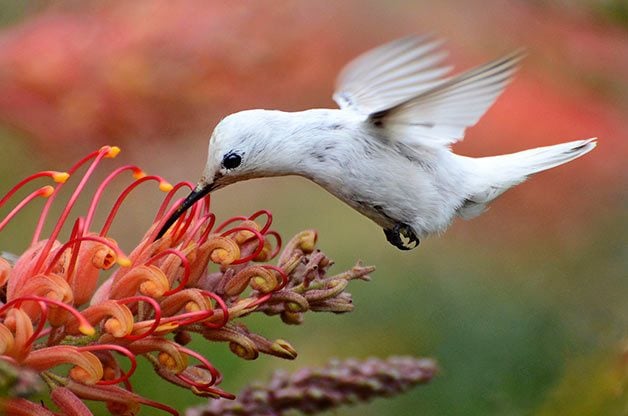
Leucistic Hummingbird
A leucistic Anna’s hummingbird visited the Australian Garden at the UCSC Arboretum, a public garden about 60 miles from my home. I love hummingbirds, so I had to drive there to see this rare bird for myself. I’d heard that seeing it was hit or miss, but I got extremely lucky. The bird streaked across the sky like a white bullet, then hovered over the blossoms in front of me. Wow! As my heart raced, I took as many hummingbird photos as I could until it sped off as fast as it had flown in! I’ve been back to look for it many times since that day. Sometimes I’ve seen it and sometimes I haven’t, but each time I do, I’m still in awe at the sight—and grateful that it graced me with its presence.
Sally Rae Kimmel Lafayette, California
Rare white hummingbirds dazzle birdwatchers.
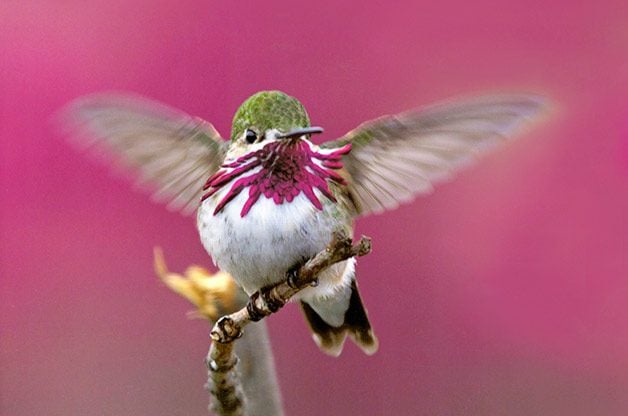
Vibrant Calliope Hummingbird
This male calliope was the first arrival of the year, stopping by our backyard in mid-April. During the colder spring weather, he would perch on this stick close to the feeder. The blurry pink background in this hummingbird photo is thanks to our crabapple tree, which was in full bloom across the yard.
Bill Bolster Medical Lake, Washington
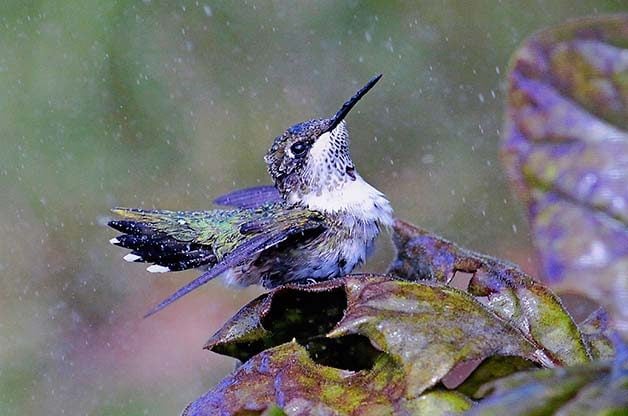
Ruby-Throated Cutie
While I was watering the flowers, I noticed the hummingbirds were sitting on the wet leaves and splashing around. I loved watching them so much, I set the hose up to keep spraying the leaves. Then I went to get the camera to start taking hummingbird photos. This was a young ruby-throated hummingbird bathing on the gerbera daisy leaves.
Mary Ann Bowyer Vesuvius, Virginia
Learn how to make a DIY hummingbird mister birdbath.
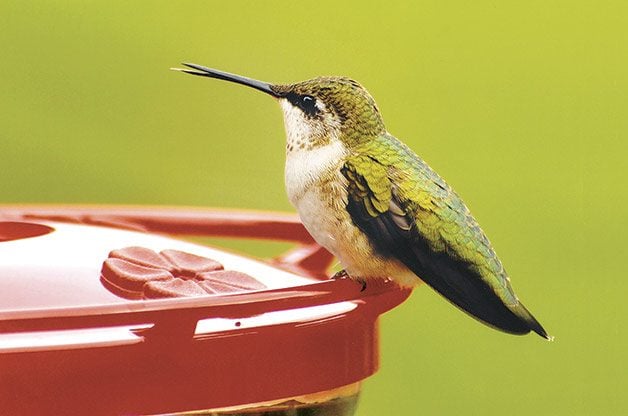
Hummingbird at a Feeder
My wife decided she wanted to have hummingbirds in our backyard, so she went to a local bird store and bought this feeder. I thought there was no way it was going to work, but within a week, there was a hummingbird! Photographing these fast little creatures was a challenge. In the beginning, my shots were really bad, but I’d try a different technique each time, and ended up getting this shot. Practice really does make perfect.
Robert Shepler Sylvania, Ohio
Check out your questions about hummingbird feeders answered by experts.
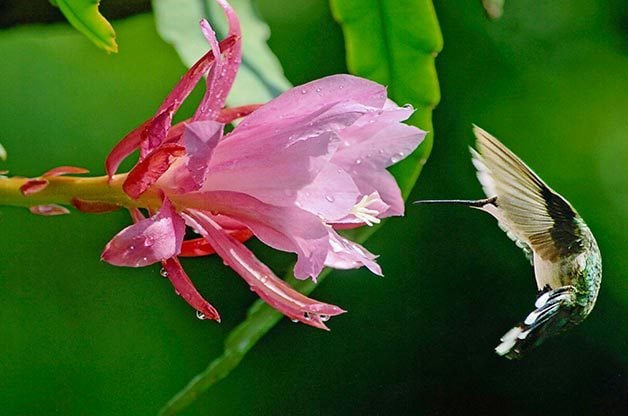
Hovering in Flight
The sun was peeking over the tree line, and I stood with a cup of coffee watching God’s creation unfold. The bloom on the orchid cactus my sister gave me was opening, so I wanted a picture of it to send to her. Right then, a hummingbird flitted over to check out the flower. With the sun shining perfectly on the bloom, I captured this wonderful moment.
Patrick Henderson Matthews, North Carolina
Plant the top 10 tube-shaped flowers that attract hummingbirds. It’s also useful to know the flowering plants hummingbirds dislike.
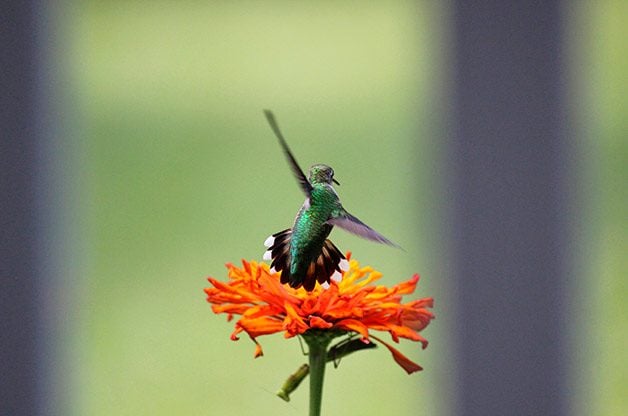
Praying Mantis Alert
I thought it was strange that this hummingbird kept circling this flower but never landed. Then I noticed the praying mantis hiding beneath the bloom. I quickly (and safely) moved the mantis to another location so the hummingbird could land on the flower without fear.
Michele Carter Newport, North Carolina
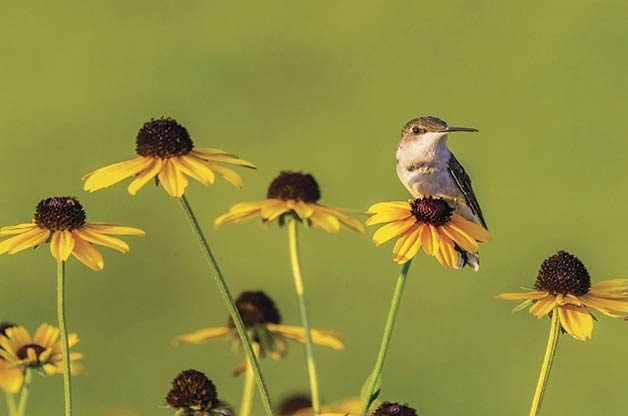
Native Plants
There was a lot of congestion at the feeders one summer evening, but this female ruby-throated hummingbird waited on a black-eyed Susan until all the drama at the “water cooler” was over before taking her turn. I’ve seen hummingbirds in trees and on feeder perches and posts, but this was the first time I’d witnessed one using a black-eyed Susan as a resting place.
Jon Montgomery Du Quoin, Illinois
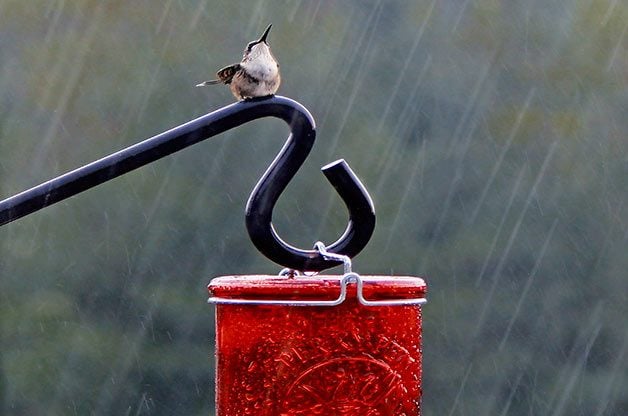
Refreshing Rain
One rainy Saturday morning, my husband and I noticed a ruby-throated hummingbird relishing the rain. These birds are usually in motion, so it was a peaceful sight to see this hummingbird perched contentedly, neck stretched with its head to the sky, truly enjoying the moment. I snapped these hummingbird pictures through our kitchen window. I love the idea that this little bird was stopping to enjoy the cool rain!
Mary Meyer Eyota, Minnesota
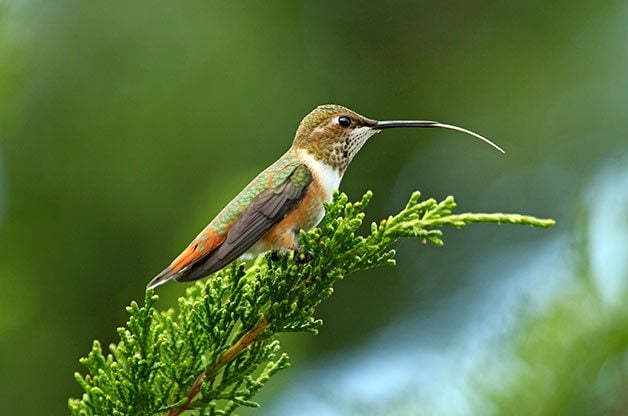
Female Rufous Hummingbird
Ever vigilant, this female rufous guarded the feeder in my yard, attacking other rufous and black-chinned hummingbirds with unbridled alacrity, then returning to this perch as lookout. What makes these hummingbird pictures special is her protruding tongue, which shows a flash of the beautiful bird’s personality.
Allen Livingston Huntington, Utah
Are male hummingbirds territorial at feeders and flowers?
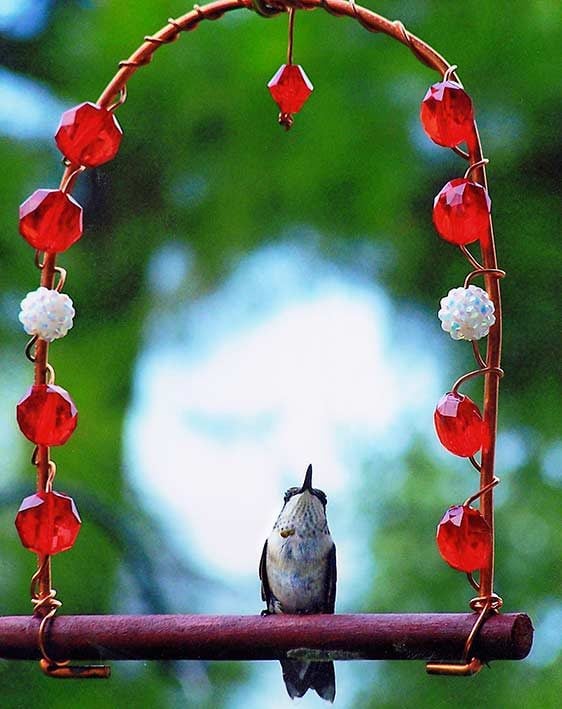
Hummingbird Swing
I made this hummingbird swing and placed it between two sugar-water feeders. The hummingbirds wouldn’t go near it until I took the feeders down. Eventually, I put the feeders back up, and one young hummingbird liked the swing so much, he declared himself the boss and used his perfect vantage point to chase
off all the other hungry hummers.
Idella Pearl Edwards Marion, Illinois
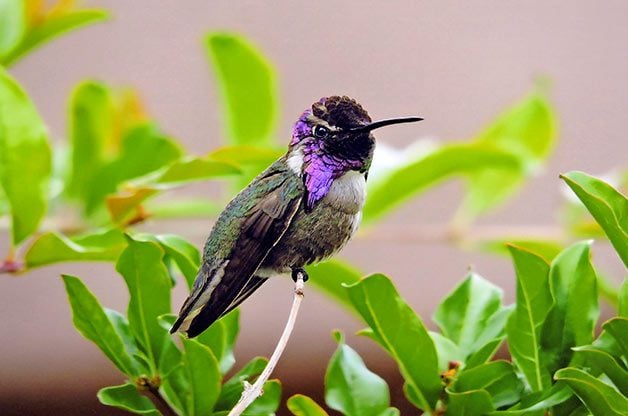
Male Costa’s Hummingbird
This male Costa’s hummingbird is actually guarding “his” feeder. Any time another Costa’s, black-chinned or Anna’s would land on the feeder, he would dash out from his hiding place in this pomegranate bush, scare away his competition and return to the exact same branch every time. His stubbornness made it easy for me to set up my camera, aim and get several good pictures.
Carla Ritter Ivins, Utah
We asked the experts: Hummingbird behavior explained
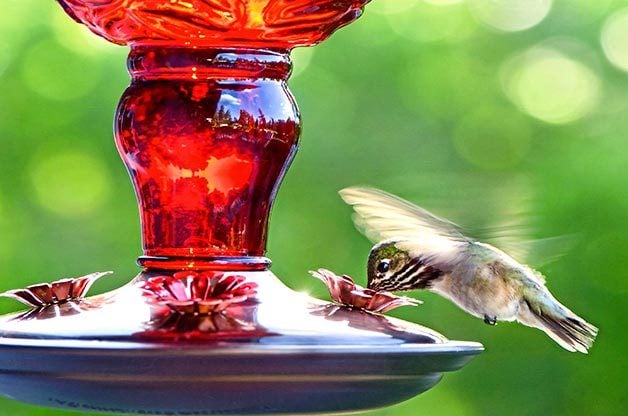
Calliope Hummingbird at Feeder
Last spring, I set up feeders in the hopes of finally attaining my dream of having a hummingbird-friendly backyard. Within a few days, I had my first visitors, but my next challenge was to photograph them. I spent hours patiently waiting to get the perfect shot. The day I took these hummingbird pictures, the sun was filtering through the trees in the neighbor’s backyard, creating a stunning backdrop. A lone male calliope took his position at the feeder, and with a few quick clicks of my camera, he was gone. But I got my shot!
Tiffany Hansen Spokane, Washington
Discover the truth about common hummingbird myths.
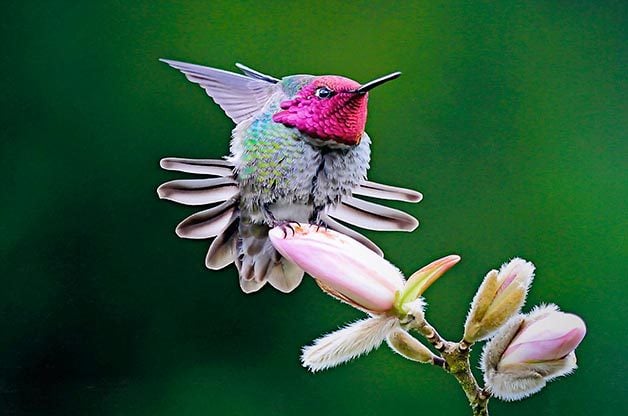
Showing Off
Male hummingbirds sure are territorial! One day, two of them were fighting for the same space in my backyard. I was watching the scene unfold when I saw this male Anna’s hummingbird all puffed out. I was so fortunate that I could capture the moment with my camera.
Lynne McClure Vancouver, Washington
Hummingbird size: How much does a hummingbird weigh?
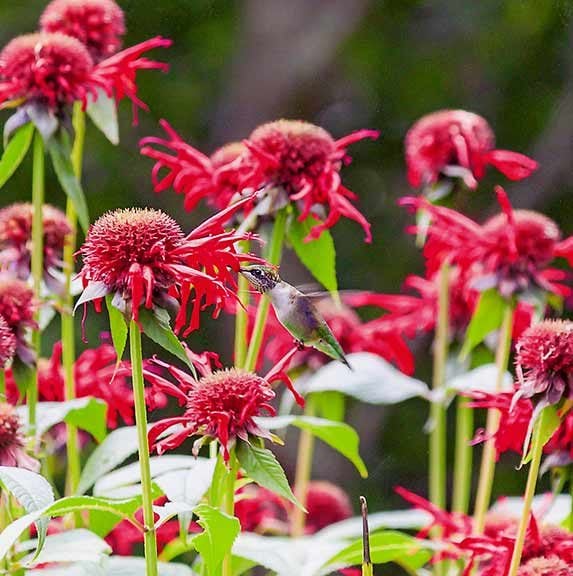
Hummingbird Blooms
Growing up in the city, I never really saw a hummingbird up close. Once I moved to the suburbs, I started planting flowers in my backyard. The hummingbirds absolutely love the bee balm, and it’s exciting to see them come back every year. Now I’m adding even more plants to attract as many hummingbirds as I can!
Carmen Rugel Middletown, Rhode Island
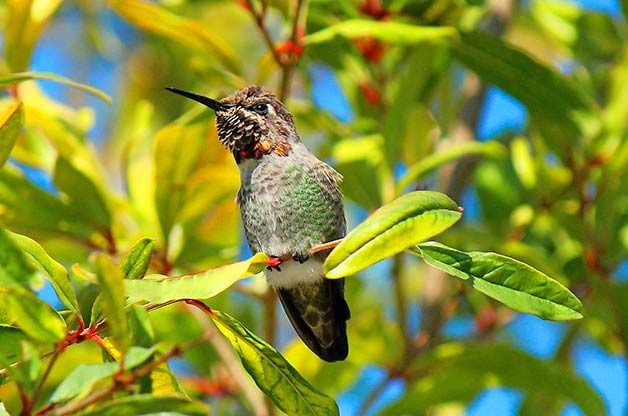
Tiny Bird in a Tree
This lovely male Anna’s hummingbird was perched in a pomegranate tree in my neighbor’s backyard. He was fiercely guarding the feeder that hung nearby. When any other birds approached, he chased them away, then flew back to his perch. Hummingbirds are so small, yet so aggressive when protecting their territory. I admired this little guy’s persistence in guarding his spot. The look in his eye shows a lot of strength for such a small bird. He has the eye of the tiger!
Robin Hardin Los Alamos, California
Don’t miss the best gifts for hummingbird lovers.
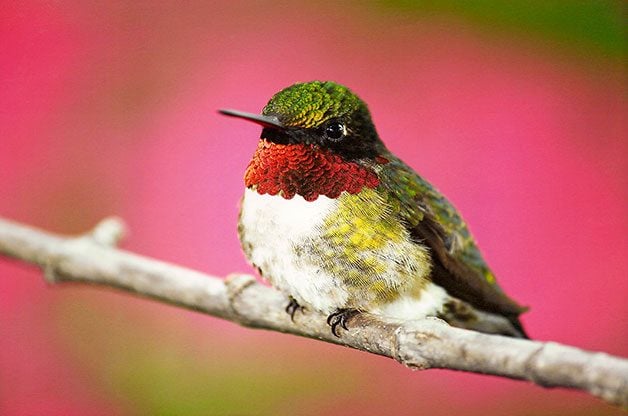
Red and Green
This male ruby-throated hummingbird was extremely friendly last summer. We took this photo in our flower garden last year. It was late in the evening, which is when this guy would sit a lot and luckily, we were able to get pretty close to him for these hummingbird pictures. After he left, a younger, much more aggressive, male hummer came along. We sure enjoyed our up-close interactions with him while they lasted.
Dennis McNeill Clio, Michigan
When should you put out hummingbird feeders in spring?
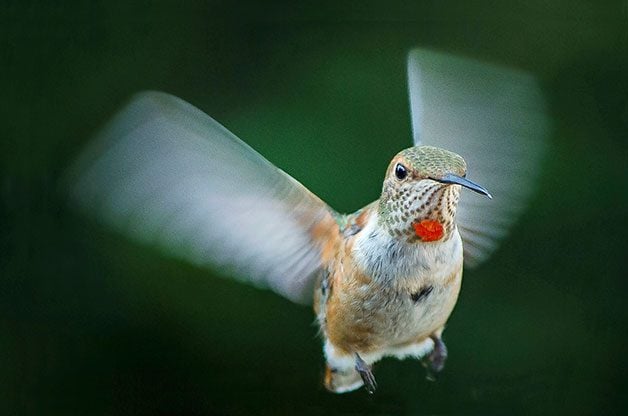
Wing Speed
Hummingbirds are difficult to photograph because they move so quickly. But I managed to get this rufous looking right at me while I captured the movement of its wings.
Maralee Park Bend, Oregon
Check out our favorite hummingbird books.
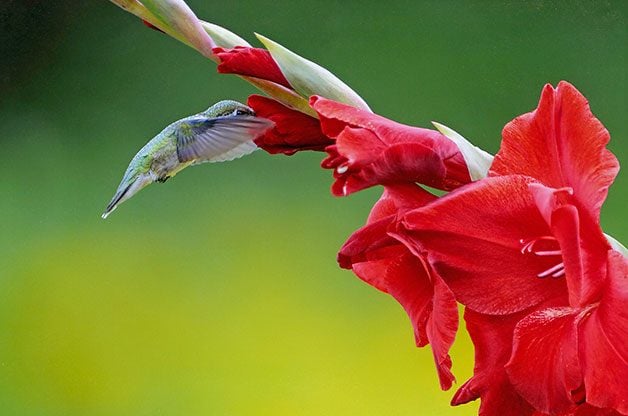
Nectar Lovers
Gladiolas are one of my all-time favorite summer blooms, and while I was taking pictures of the ones in my garden, I noticed I had company. A juvenile ruby-throated hummingbird was also interested in the blooms! I shouldn’t have been too surprised because hummingbirds like the color red, but it really brought a smile to my face.
Patty Jennings Stacyville, Maine

By the Dozen
These ruby-throats come back to my front yard every year, and I love to sit and watch them. Occasionally, things really get out of hand when 15 or so try to feed at the same time.
Clatis Tew Butler, Alabama
Psst—Hummingbirds will flock to a hummingbird mint plant.
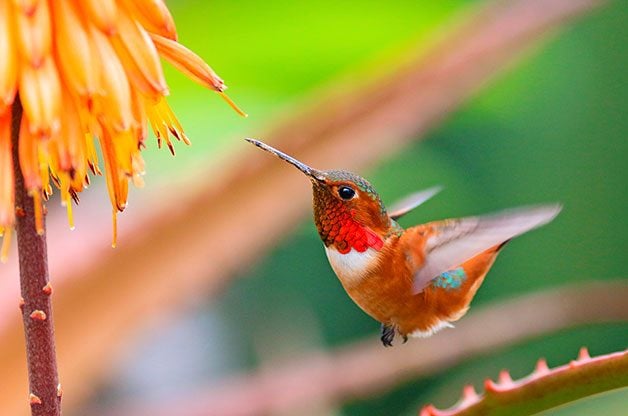
Beautiful Hummingbird
Southern California is drought-stricken, and water-wise plants, like this aloe plant are encouraged. Luckily, hummingbirds are frequent visitors to the aloe blooms alongside my driveway. The perfect combination of wildlife and drought-tolerant plants makes an amazing photo op!
Koji Kanemoto Long Beach, California
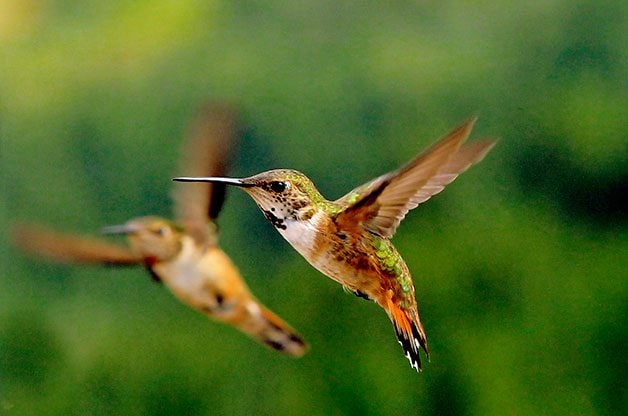
Double the Fun
I took these hummingbird pictures in a Utah park. There were several feeders and more than 20 hummingbirds zipping around. These birds tend to be elusive, flying away before you can get a good look at them. Having so many in one spot allowed for this interesting shot with another bird out of focus in the background. These birds are like magic, and each time I look at the hummingbird photos I’ve taken of them, I remember hearing the unique sound of their wings and bodies cutting through the air.
Helene Bushnell Lowell, Massachusetts
Next, never add these foods to your hummingbird mixture.
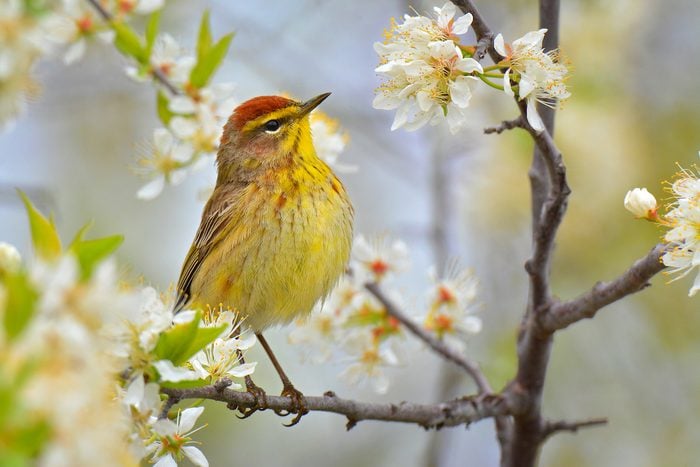
Seasonality is a strange thing. Those of us who live far from the equator integrate the seasons into our lives quite naturally. We are always aware of the change of the seasons—the shifts in light and temperature, the changes in the trees, flowers and crops in our gardens. For a bird watcher, these changes are even more dramatic, as each season brings its regular species, highlights and, yes, even periods of the doldrums. Birds adjust not only their plumage, behavior and food based on the seasons, but they also make mind-bending migrations across continents and oceans in response to them. These movements and behaviors add a dimension to the year-round changes for those of us who watch birds. Each season bring something new, something different, something that demands that we sit up and pay attention.
Birdwatching for beginners: Learn how to start birding.
Watching Birds in Winter

Winter can seem dark, cold and lifeless for a bird watcher. Those of us who live in the northern part of the country (very far north in my case of Fairbanks, Alaska) are accustomed to snow, frigid temperatures and a landscape that can seem void of any living thing. From a winter birding perspective it can be monotonous. Common feeder birds flit in and out, the same few species, day in and day out. We long for the days of spring and summer.
But then, during one of our periodic glances out the window, something different appears. A pine grosbeak, perhaps, a northern shrike or a red-breasted nuthatch. The new bird flies into the branches, scattering a flurry of snow as it lands. The colors and patterns of the new arrival help us forget about the cold, the dark and the monochromatic landscape. We become entranced by the bird at hand.
This is winter birding for me in the interior of Alaska, but a similar story can be told by a bird watcher virtually anywhere. In western Washington state, where I attended college, winter was one of the finest times of year for birding as species from across the North congregated in the wetlands and estuaries. And although there was far more diversity in those wet coastal forests than here in Alaska, one trait remained constant: Things often seemed the same, day after day. Rain there, snow here. The species were usually the same, though there were far more of them. But the rarities and the surprises served to remind me that despite the apparent monotony, things were not always the same after all.
Discover 7 types of finch birds to look for in winter.
Winter Bird Watcher Checklist
- Add an electric deicer to your birdbath, or buy a birdbath with a built-in heater. Birds need water every day, even when it’s cold out.
- Notice robins and bluebirds that stick around in cold and snow. These birds don’t always head south in winter. But their habits may change—they often travel in flocks this time of year.
- Brush snow and ice off your feeders and your flowers, and keep berry bushes clear. Birds are most vulnerable after a snowstorm or ice storm. You can also use part of your cleared driveway for ground feeding, so juncos can easily find their millet.
- Look for irrupters—species that suddenly show up where they’re not usually seen in winter. Flocks of evening grosbeaks, pine siskins, redpolls and crossbills often do this.
Discover 5 foods you should feed birds in winter.
The Joys of Spring Birding

The pleasures of being a bird watcher really come to light during the changes of the seasons. Wherever you live in North America, the appearance of the first migrants is a cause for celebration. It is a sign that winter has lost its grip and the warmth of spring is not far away. Every spring day is a bit like Christmas because there is bound to be a new gift waiting, if one is willing to look for it. In the South, the first signs of spring may not be the arrival of a new species but the sudden absence of the winter residents. Meanwhile, farther north we wait for the arrival of those same species: snow buntings, juncos, longspurs or robins. Spring is a fleeting time of sudden and constant change. It forces our attention, incites the desire to step outside, to listen and to watch.
Spring is also a time of sudden and ephemeral abundance. Weather patterns and migration occasionally coincide to create what are known as “fall-outs.” Like construction on an interstate, bad weather can create a traffic jam of sorts along the migration route. Countless birds can be caught up behind the storms, waiting for their chance to move north once again. This phenomenon is particularly dramatic along the Gulf of Mexico and the Great Lakes, where flocks of migrants sometimes descend from the sky, decorating the shrubs and trees like colorful, living ornaments. Migration, of course, is not always so dramatic. Often it is as simple as backyards, recently silent, newly filled with the sounds of birds. Not all species arrive at the same time. The sparrows are often first, heralding the arrival of others. Birds arrive one species after another until the last wave of wings has flowed north up the continent.
When should you put out hummingbird feeders in spring?
Spring Birding Checklist
- Make sure your birdhouses are ready to go. Bluebirds are among the earliest nesters. They use man-made housing and like it facing open fields. Mount the proper house about 5 feet high on a pole, and keep an eye on it to make sure house sparrows don’t move in. Learn how to make a DIY bluebird house.
- Use cling decals on your windows to keep spring migrants from crashing into the glass. In spring and fall, more birds are on the move, making them more likely to die from run-ins with windows. Learn how to help a bird that flew into a window.
- Remember that not all birdhouses are suited for your favorite fliers. Find our birdhouse guidelines, or check with a local backyard-bird store to find out which houses are suitable for your resident birds.
- Offer birds nesting materials. Put these in a mesh bag or an empty suet cage—the birds will love it.
Get ready for baby birds with tips for bird nesting season.
Summer’s Flurry of Birding Activity
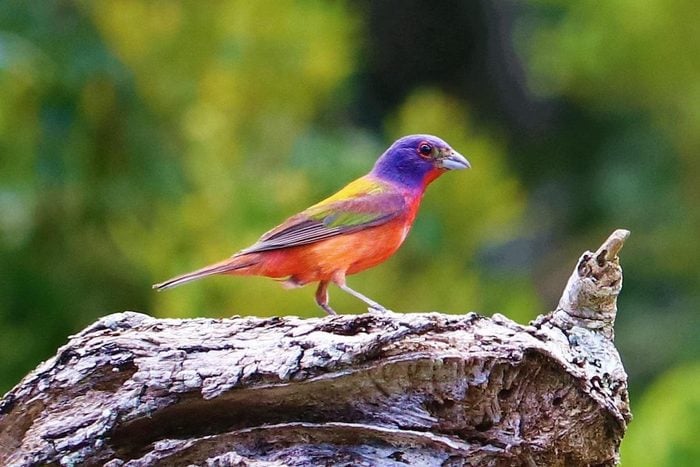
When the blasts of heat arrive with summer, the birds change their tunes. They, like us, settle into a routine. Summer, so different from winter in many respects, surprisingly bears some similarities. It can be a time of apparent stagnation. But, unlike the cold months, it is the stagnation of a tropical lake. Still, yes, but filled with expanding life as nests are constructed, eggs laid and hatched, nestlings fed and eventually fledged. The species may not change all that much, but the birds are boisterous and multiplying.
The mottled browns and streaky plumage of the first juvenile sparrows challenge the identification skills of the most astute birder. Then as observers get a grasp on the sparrows, fledgling warblers and flycatchers appear, and the challenge begins anew. Confusing us more, adult birds look worn and tattered, like the tired parents they are, and seem to sulk in the brush, exhausted. Watching birds at this time is challenging and exciting. For a few weeks in July and August the trees are again filled, as fledglings disperse and adults start to fuel up for the molt into their winter plumage and the migration to follow.
Discover 9 easy tips for feeding birds in summer.
Summer Bird Watcher Checklist
- Learn how to tell if you’re seeing a juvenile bird. By the time young birds leave the nest, they’re almost as big as their parents. So watch for clues—such as youngsters flapping their wings begging for food or looking rumpled as their feathers grow in.
- Go on a nest hunt. See if you can spot a few nests hidden in the trees and shrubs.
- Don’t assume young birds on the ground have been abandoned. In most cases, they don’t need our help at all. They’ve probably just left the nest, and the parents aren’t far away.
- Keep an eye out for warblers and other fliers as they begin to head south for winter. Migration isn’t just a fall phenomenon. It starts in late summer.
- Remember that not all birds will be in their typical spring plumage. Challenge yourself to identify the mystery fliers you see.
Meet the Vireo bird family: sweet summer singers.
Watching Birds During Fall Migration
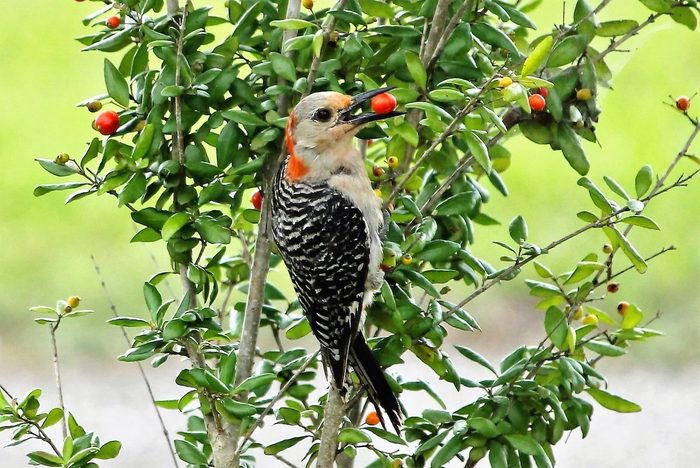
One day in September a species or two goes missing. Like a party-goer who attends out of politeness or obligation, the last species to arrive is often the first to leave. Here in Alaska, the alder flycatcher, a species that spends only around 6 weeks on the breeding grounds, is the first to flee the North and start its journey to the far southern portion of South America. Soon another summer bird species follows, then another and another. By early September, in my neck of the woods, there is a veritable flurry of fluttering wings as one after another the migrants pick up and fly south, the first tendrils of winter brushing their retreating tails. As winter again grabs control of the landscape, left behind is a small cluster of resident birds breathing a sigh of relief as they reclaim the forests, fields and backyard feeders as their own.
Discover the top 5 birding hotspots for fall migration.
Fall Bird Watcher Checklist
- Don’t forget to look for goldfinches. Even though they lose their familiar gold coloring in fall and winter, they’re still out there looking for seed like thistle.
- Watch for flickers eating ants and towhees searching for decaying matter before the ground freezes.
- Pay close attention to juncos. Their arrival in fall marks the transition from warm to cool weather. Dark-eyed juncos have white bellies, which you rarely see because they eat on the ground. Try to glimpse a flash of pure white before they fly away.
- Keep track of your backyard visitors by writing them down. You can track patterns and behavior. Birds are creatures of habit. Next fall, you’ll have an even better idea of what you’ll see and when you’ll see it.
Check out the 9 best fall bird feeding tips.
Who doesn’t love a beautiful, healthy yard? Some may opt for edible landscaping while others focus on the bright hues and fragrances of certain blossoms (like these gorgeous blue flowers). No matter what you grow, it’s important to take the correct steps for proper care.
So when it comes to mulch and compost, all you seasoned gardeners out there know a thing or two. But what’s that white stuff on mulch?
That White Stuff on Mulch Is Slime Mold
Yes, that odd, spongy mass of white spores is actually a slime mold. But a slime mold isn’t actually a fungus in the sense of the word as we understand it. Instead, it’s more like an amoeba and often appears as a giant, icky blob. They don’t really identify as either plant or animal and actually exist to decompose organic matter.
This particular type of slime mold spreads through individual spores. It may not look the prettiest, but it’s beneficial to your organic mulch. The slime mold will actually work to return vital nutrients to your soil! It’s not poisonous or toxic and typically dries up and spreads its spores elsewhere after awhile.
How to Get Rid of Slime Mold
There is no surefire way to prevent slime mold from appearing on your mulch. And, as I mentioned before, it really only works to help instead of hurt. However, if you find the white slime is conflicting with your aesthetic, you can simply bury the mold into the mulch itself.
You can also use a rake to remove the mold and dispose of it somewhere else, or if you’d prefer to wait for it to finish its job, let it dry out to powder and blast it with a hose. Just remember to say thank you for all the hard work it’s doing for your beautiful flowers!
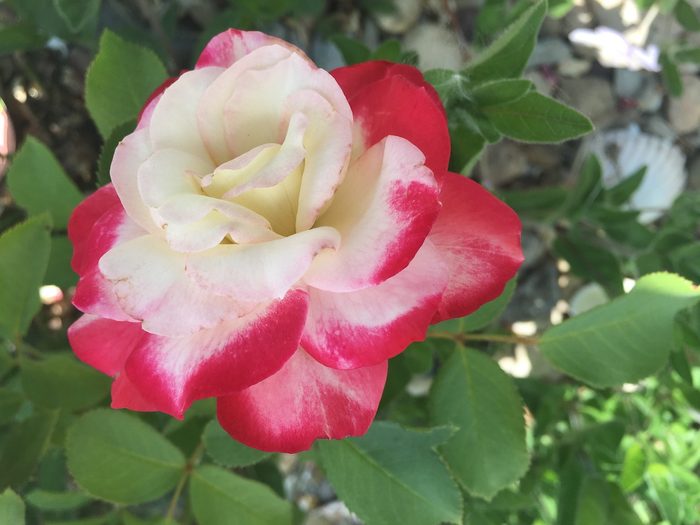
The June birth flower comes in countless shapes and sizes, from a bouquet of classic red roses to rugosa roses and fast-growing climbing multicolored roses. Here’s everything you need to know about the colorful and fragrant June birth flower, including some surprising facts. And if your loved ones have June birthdays, we found the best birth flower gifts to help them celebrate their special day.
Not celebrating a June birthday? Don’t’ worry—we’ve got you covered with January, February, March, April, May, July, August, September, October, November and December birth flower gift guides too. Bonus: See if your birth month flower has a special meaning.
What Is June’s Birth Flower?
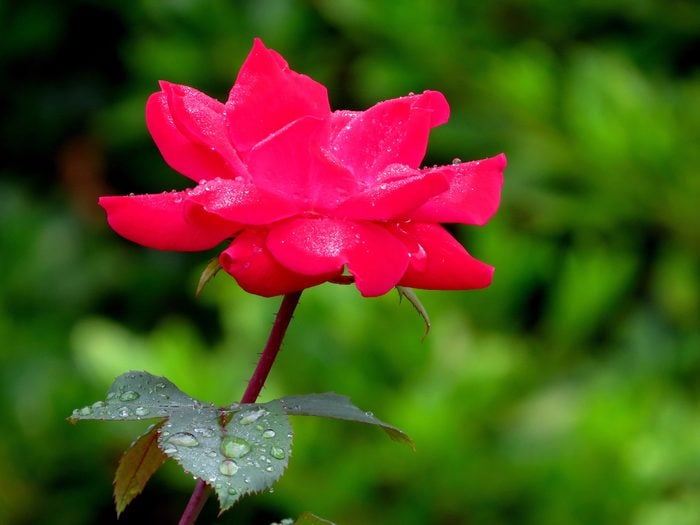
June’s birth month flower is the rose. Not any rose in particular, which is a good thing because there are well over 30,000 varieties of roses worldwide!
Generally, roses are categorized into three main types: wild roses (or species roses), old garden roses and modern garden roses. Wild roses go way, way, back. They are thought to be 35 million years old and are the source of all other rose varieties. Their flowers often have only a simple row of petals. Old roses, sometimes called heritage or historic roses, are roses bred before 1867. Last, but certainly not least, modern roses come in a variety of sizes, colors, and new forms like mini and landscape roses. Did you know roses are also the national flower?
Roses not only look many different ways, they also come in a multitude of scents ranging from classic rose to spicy—and even fruity. Check out these fragrant roses you can add to your garden.
What Are the Meanings of June’s Birth Flower?
The rose is generally known to represent love, beauty and devotion. But roses have the unique power to carry their own special meanings based on their individual color. Red roses, which are a popular gift on anniversaries and holidays like Valentine’s Day, are the symbol of love and romance. Yellow roses symbolize friendship. And white roses mean innocence, purity or sympathy. Learn more about the many rose color meanings.
More June Birth Flowers
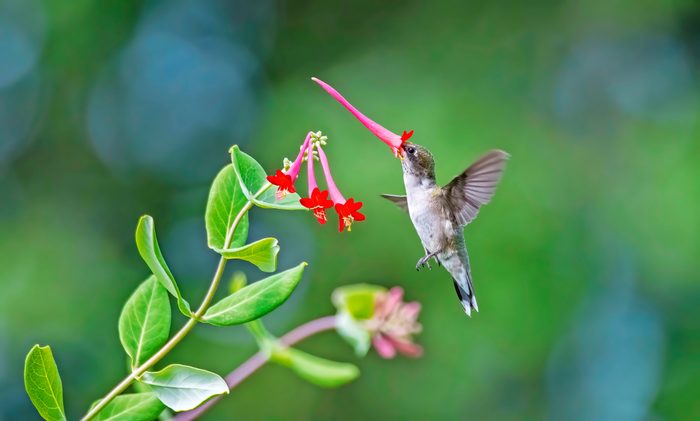
The honeysuckle is the other June birth flower. A symbol of happiness and affection, this plant produces colorful trumpet-shaped flowers that have a sweet scent that’s especially strong during the evening. Many types of honeysuckle are invasive—but the trumpet honeysuckle is one exception. Not only is a gorgeous addition to any garden, the trumpet honeysuckle is a favorite for hummingbirds.
Now that you know more about both of June’s birth flowers, we’ve got the perfect rose and honeysuckle gifts for everyone on your June birthday list—from bouquets of fresh-cut flowers and custom stationery sets to rose-scented diffusers and jewelry.
June Birth Flower Gift Guide
Rosebud Earrings

These pretty half-moon earrings are a fun way to showcase the June birth flower any time of year. Each earring is handmade with vibrant red rosebuds in an eco-resin. The roses are sustainably grown from South America, and each pair is completely unique.
Mixed Rose Bouquet

Send a farm-fresh bunch of two dozen colorful roses to celebrate a June birthday. Sending flowers, like a bouquet of vibrant roses will make anyone smile on their special day. This is an especially nice birthday gift option if you live in a different state.
Rose Jewelry Dish

Each of these hand-shaped jewelry dishes are imprinted with stamped custom birth month flower drawings, then painted in a rich red rose hue. The name of the month and flower, along with the flower’s meaning, is stamped into the bottom of the dish. It’s the perfect personalized June birthday gift! Psst—don’t forget to send a card.
Rose Stationery Set

This personalized stationery set comes with a suite of products featuring gorgeous light pink roses and the name of your choice. The set includes folded and flat note cards with envelopes and a 50-sheet notepad. This rose gift will definitely earn you a thank you note!
Garden Rose Diffuser

Gift the scent of a fresh-cut bouquet of roses any time of year with this Monique Lhuillier garden rose diffuser. This rose gift adds scent to a room for up to one month and the pink bottle is an elegant accent.
Rose Keychain

This personalized key chain is handmade with real, pressed roses and golf leaf in the the letter of your choice. This thoughtful gift will be enjoyed any time they open the front door.
Rose Name Necklace

This beautiful necklace features a combination of the June birth flower, a rose, and the name of your choice. Customize it with the length and metal of your choice—gold, silver or rose gold. Of course, we recommend rose gold to keep the June birth flower theme going!
Trumpet Honeysuckle Plant

Want to gift more birds in their yard? Trumpet honeysuckle plants are very attractive to hummingbirds. This non-aggressive climbing vine features beautiful red blooms and matures up to 20 feet tall. It’s a fantastic June birth flower gift for the gardener who also loves hummingbirds.
Honeysuckle Candle

Enjoy the sweet scent of honeysuckle with this hand-poured candle. The reusable eight-ounce rocks glass container has a beautiful honeysuckle printed on the outside. Enjoy the container as a decorative glass or jar long after the soy candle wax has burned.
How to Control and Kill Bermuda Grass

“What’s the best way to encourage flower seedlings in my garden and kill Bermuda grass?” asks Nathan Lembke of Bentonville, Arkansas.
Gardening expert Melinda Myers has advice: “It’s certainly challenging to manage grass in an existing garden. Pre-emergent weed killers will prevent many desirable flower seeds, as well as weed seeds, from sprouting. Instead, continue to remove the Bermuda grass by hand.”
Psst—here’s how to stop bindweed from taking over your garden.
“Spot treating the Bermuda grass plants with a total vegetation killer is another option,” Melinda says, “but be sure to protect desirable plants from these chemicals. You can cover a weed with a milk jug or soda bottle with the bottom removed, then spray the weed killer through the container’s opening and onto the weed. Once dry, move to the next weed. Organic products only kill the above-ground portion of a plant, but repeated application can help manage this plant. Read and follow the label directions to make sure the product you select can be used in an existing garden.” Follow these tips and tricks for a weed-free backyard.
Melinda also recommends mulching your garden with shredded leaves, evergreen needles or other organic materials to prevent the seeds of Bermuda grass from sprouting in spots where you’d rather have flowers or other plants.
Here’s the best natural way to kill weeds.
Benefits of Bermuda Grass
Despite its name, Bermuda grass was actually introduced to North America in the 1750s from Africa, not Bermuda. Sometimes known as wire grass, Bermuda grass is a known host plant for a tiny butterfly species called fiery skippers, which are often seen in the South but also are spotted as far north as the Great Lakes at times.
Bermuda grass is particularly common in the southern U.S., where it thrives in the heat and humidity. But for some people, Bermuda grass can be a pest when it grows in areas where it’s not wanted.
Discover the top drought-tolerant plants that can handle dry weather.
Bermuda grass has vine-like stolons above ground and stem-like rhizomes below ground, making it a popular turf grass for growing quickly and filling in patches in lawns.